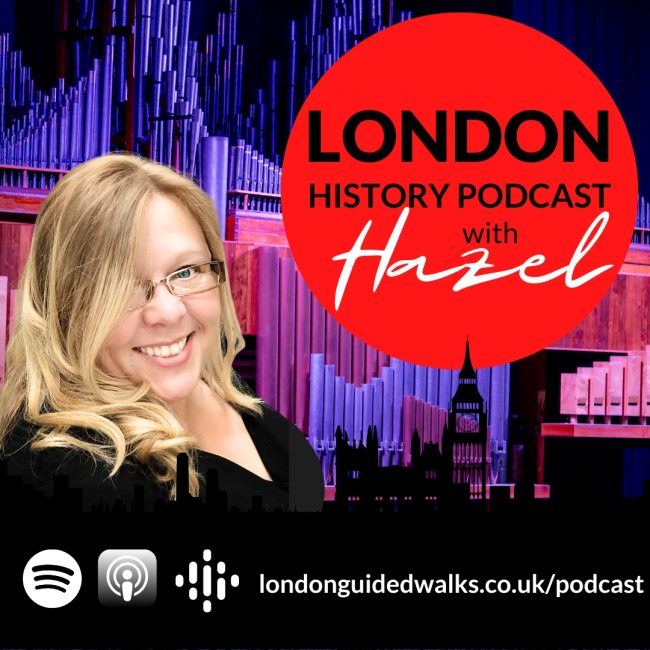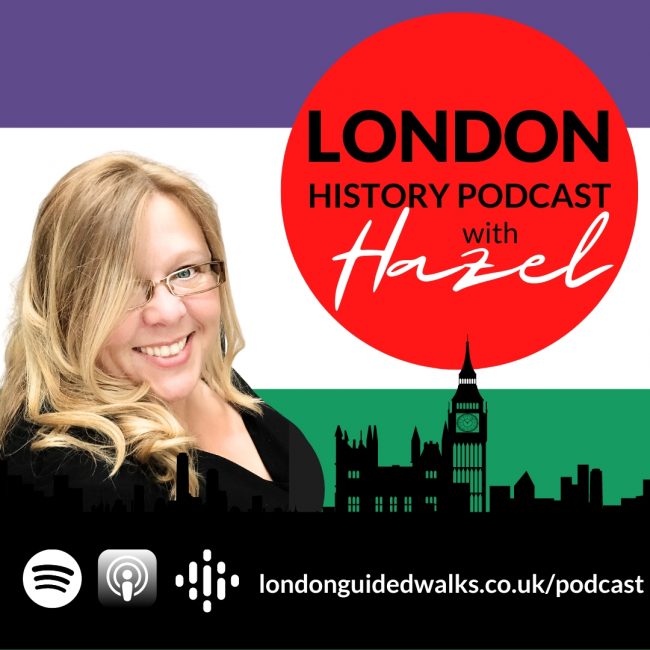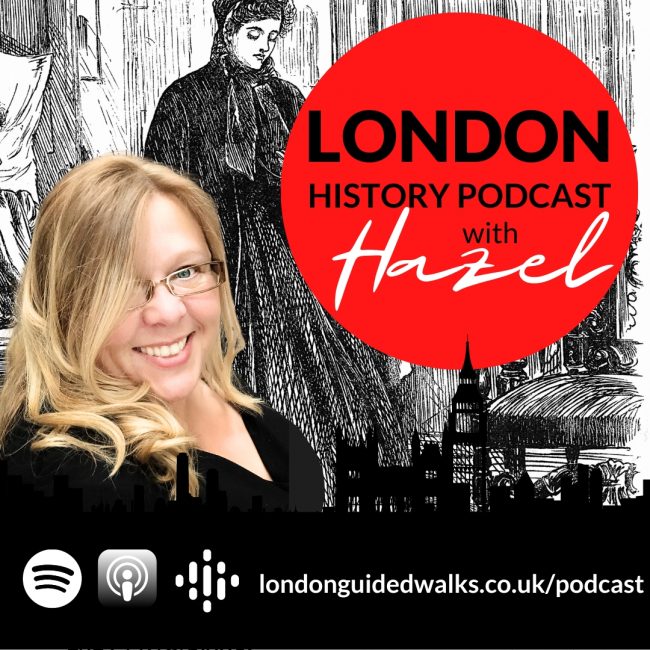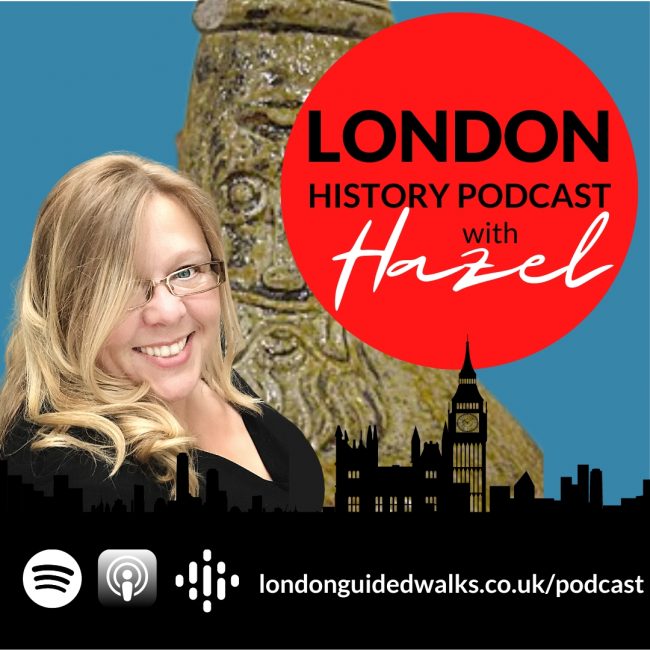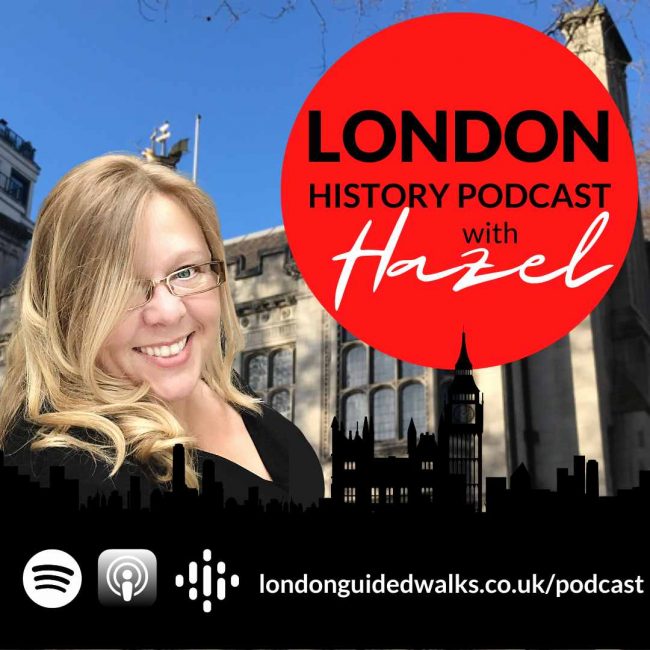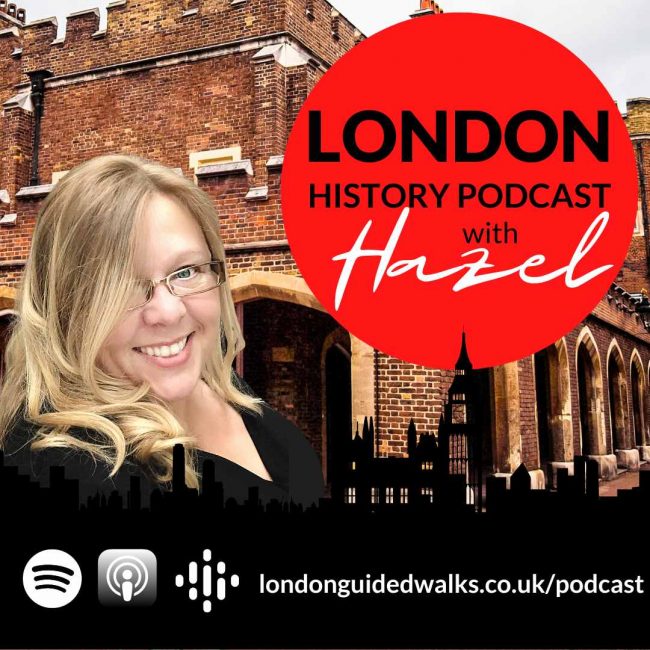The Walbrook in Roman London
Related blog posts:
Show Notes:
 Hazel Baker: Hello and welcome to London Guided Walks London History podcast. In the coming episodes, we will be sharing our love and passion for London, its people, places and history in an espresso shot with a splash of personality. For those of you who don’t know me, I am Hazel Baker, founder of London Guided Walks, providing guided walks and private tours to Londoners and visitors alike.
Hazel Baker: Hello and welcome to London Guided Walks London History podcast. In the coming episodes, we will be sharing our love and passion for London, its people, places and history in an espresso shot with a splash of personality. For those of you who don’t know me, I am Hazel Baker, founder of London Guided Walks, providing guided walks and private tours to Londoners and visitors alike.
To accompany this podcast, we also have hundreds of London history related blog posts for you to enjoy, all absolutely free. We’ve also launched The Daily London, providing you with daily inspiration of things to do in London, for Londoners. You can listen on iTunes, Spotify, or even add it to your Alexa flash briefings. And you can check all of that out on our website, londonguidedwalks.co.uk/flash.
Today, we’re going to be talking about the Walbrook stream in the city of London during Roman times. And to help me navigate this, is city of London tour guide, Ian McDiarmid.
 Ian McDiarmid: Hello.
Ian McDiarmid: Hello.
Hazel Baker: Hello. Okay. So, we know the Walbrook stream began as Springs. In modern day, Islington and Shoreditch. And flowed through Central London, reaching the Thames by Cannon St. Station.
Ian, to help those who aren’t familiar with the Walbrook or indeed, the city of London, would you want to pinpoint the Walbrook a little bit closer?
Ian McDiarmid: Yes. Well, the first thing to say, obviously that it is, one of London’s hidden rivers, so, it’s been covered up for very long time now. In fact, by the end of the 15th century, it was getting incredibly narrow and was pretty much covered over for its entirety.
It begins in to the North of the city in what was more fields and then ran southwards. And when we say it began around there, the beginnings of the Walbrook covers a very wide area. And it’s a very diverse thing to describe because actually it’s not really one stream. It’s several streams coming from several springs and those several Springs then come together, spit further South and form one stream and what we turned the middle Walbrook. And the middle Walbrook ran under where, now the bank of England is, and then it ran further South onto what is now underneath the Bloomberg building, formerly Butler spray house Butler spray house was pulled down. And Bloomberg building is on a road called Walbrook and Walbrook road is a little to the East of where the Walbrook ran, and then it ran down towards to the Thames and its mouth was there on the Thames near Camden St. Station.
So as I was saying, this is completely hidden, and this is one of those sort of fascinating, historical aspects to London when you can’t really see anything of what you’re talking about, but you’re talking about something that was of immense importance.
So what I was saying, we can divide the Walbrook stream up into three parts. I should actually say that it’s only a mile long, so we’re doing a podcast now on a kind of trip down a river, and it’s a bit like doing or watching one of those BBC documentaries. When somebody like Michael Pailin goes down the Nile or the Danube a bit similar, except that a river or stream more properly is only about a mile long.
And so the Northern parts of this, as I said, cover quite a wide area, and this is the upper Walbrook. And we’ve got to think of a series of, as I say, small streams fed by springs. And when the Romans arrive in London, this area is very, very marshy and they begin to develop it around, 90 to around 120, it gets going AD.
And so this is a bit after the first Roman settlement of London. They conquer in 43 in the first bit of archaeology, which we’ll probably come to a bit later is 47-80. And the thing that distinguishes this area in terms of archaeological finds is industrial activity. So this is the part of Roman London, where industrial activity was most concentrated.
We’re talking about finds of leather working, metal working, glass working and also, pottery as well. And so I was saying earlier that for me, the interests of this is that there’s not much to see and you’ve got to recreate it in your imagination. I remember walking up Moorgate a few weeks ago and remark, just making a mental note of 20-24 Moorgate, which is on your left as you walk up Moorgate towards the Bank of England to say, walk up that’s heading in a southerly direction. This is a completely unremarkable building. They put it up in 1999, they did the archaeology underneath there and they found the remains of killed. And so to me, that that’s kind of brilliant, interesting.
Hazel, you’ve been interested in the Crossrail excavations. Could you explain where they were and what they found?
Hazel Baker: Yeah. So the Crossrail excavation, so I’ve been doing the, the Broad Gate and the Liverpool St. one, that’s what I’ve been reading up about. And it’s really quite fascinating. So, in modern day maps, Bloomfield St. is where the Walbrook would have originally ran. In Roman times, don’t forget, you know, public buildings, would have been onsite the main roads leading out of the city. It was a legal necessity and also, so the custom to bury dead outside the town boundaries. So I think, you know where I’m going with this one. And Walbrook was a fast flowing stream. And the area was prone to flooding. Cemetery areas nearest to the streams tributaries must’ve been constantly waterlogged and that’s good for finding fines and the passengers that weren’t used for sanitary science were used for military horses.
Ian McDiarmid: How do they know that?
Hazel Baker: Oh, well, by the bugs that they found in the soil. They’re called decomposers and they are associated with stable waste.
Ian McDiarmid: Oh okay. Now one of the things I remember reading about the upper Walbrook is I think a bit before, when you’re talking about is the exposure of bodies in the, rebates in the iron age, carrying on into the Roman age. And you mentioned that the stream is fairly fast flowing. In the lower Walbrook, they found a lot of skulls. And when these were found, it gave rise to some fanciful theories about battles, and weather or was it during the Boudican Revolt. And I think some people, modern scholars, someone’s scholars maintain that they could be, people who were executed, during the Boudican Revolt.
But the more likely explanation is I think of the skulls being…of bodies being exposed in the river and the skulls perhaps being detached at the time of the bodies being laid down and then being carried down by the water to the lower Walbrook. Is there anything in that, about Latin the Crossrail or, or was it later and is it burial?
Hazel Baker: I’d love to add these stories, you know. You see a head and you think, oh, well it’s not attached to the body, so it must have been deliberately taken off, but there’s no evidence for that at all. So the modern day view really is that these heads came off because of the flooding and moved down the river, as with lots of other items.
Ian McDiarmid: Okay. And what about the cemeteries? Is there anything of particular note that they found there?
Hazel Baker: Yeah, so they’ve found a number of things, including, coins. Some beautiful coins, including one from Trajan and another one Hadrian. Another one also I’m specifically representing the province of Britannia.
Ian McDiarmid: Oh, okay. Well that sounds good.
Hazel Baker: Yeah. On a more gory note, if you like that kind of thing, they have found a horses’ skeleton, partial skeleton. A male, five years old and it’s laying on its right side and it’s been part butchered. And they can tell that because of the knife marks in the front mid shaft of the FEMA and also on a rib, but it also has evidence of canine gnawing.
Ian McDiarmid: Yeah. Nice. So that was something that was just left there was it?
Hazel Baker: Yes. It looks like it was a deliberate deposit. In five years is pretty good going for any working horse.
Ian McDiarmid: Oh, that’s interesting. Cause I think you were telling me that in Victorian times, horses didn’t live very long, did they?
Hazel Baker: No they didn’t then they ended up with loo afterwards.
Alright, yes. They also found a rare example of refined joinery from early Roman period. And these are two reused timber Gates or bond doors. So going back to this whole posture, feeling of what the area was used yard. So they’re thinking of farm yard or a workshop or some sort of ancillary building, and they reckon that this was done by a semi-skilled owner rather than a professional joiner, just by the way that it’s done.
But they’re putting the date here at 110, 134 AD. And it’s two meters wide, so quite sizeable, so perfect for horses. And then also don’t forget, at Drapers gardens they’d found two domestic size doors and they were rather than simple but the most elaborate ones they’ve found over the years is on the Bloomberg site and these are smaller sections, but they are two really elaborate panels. So you’ve got three examples of different types of joinery, the home DIYer to the professional, joiner, all in these three examples.
Ian McDiarmid: And what about the burials themselves?
Hazel Baker: Yeah, well, of course cemeteries usually flanked main roads and Finsbury circus cemetery began in the late first century. And this is before the construction of the road that we know today. And it all continued for 200 years into the third century and they have found they’re flanking some of the Bloomfield road. They found examples of, 125 human burials and also 10 cremations.
And then at Liverpool street, five burials and a partial. At Wellesley and also in the channel seven individuals, including six adults, one male, definitely one female and one sub adult. And because they were found not as whole bodies in channels, along the side of the road, they’re thinking that maybe the cemeteries were actually tidied up and these deposits, were left in there.
The bigger bones and also the foot bones were missing. That’s a bit weird.
Yeah. Why is that, you think?
No idea. Maybe good luck charms? I dunno. Yeah so, grave goods were found in smash spots. And some of the most beautiful ones were, polychrome cable bracelets and also 2 bone hairpins, also a probable iron medical instrument. So maybe he was a doctor! An iron stylists and also 2 iron slide keys. And mixed into all of this are 199 animal bone fragments.
Ian McDiarmid: So what animals did they find there then?
Hazel Baker: Well, mainly cattle, sheep, goats, pigs, dog, chicken. And then they also found single fragments of goose, cod, and horse.
Ian McDiarmid: Good mixture.
Hazel Baker: Shall we move to the middle Walbrook then?
Ian McDiarmid: Yes. And, this really, we can begin to talk about why the Walbrook is so important. And it’s important because it’s an incredibly rich archaeological area. And the reason for this is the Walbrook itself and that process I was talking earlier about the building up and banks. On the middle of the Walbrook they were constantly building up the banks and they were gradually building up more solid areas where buildings could be erected. So you’ve got various levels of material being dumped and this preserves archaeology very very well because it’s unerrodic, there’s no oxygen in there. So you’ve got these various levels of building and you get lots of remains.
And it’s also very important for the history of archaeology because Bucklers bury House, which I was talking about earlier on, which was a huge building put up in the 1950s. And when they did that, the excavation before it was both extremely important, but very limited. So this is the time when Professor Grimes excavates the Temple of Mithras and this created huge, huge interest at the time. People queuing around the block to see it. And at the same time the Guildhall Museum as then was now part now later on became part of the Museum of London was able to carry out some what we would call rescue archaeology, some rapid trenches. But an awful lot of the archaeology just disappeared under the constructors machinery. And you can see film clips at the time of these huge bulldozers moving masses of earth. And the archaeology that went must’ve been, well it’s, it’s tragic to think of it, but the results and outcry over that led to some of the beginnings of the restrictions on development in the city and, and the beginnings of the current regime whereby you have to undertake archaeological surveys and archaeological digs, if you want to put a new building up.
And the area was also very important because they had to… the Woodbrook came, as we were saying, North South and it’s to the Western side of the city. But the city developed beyond it. So they had to put a bridge across and the bridge went across roughly where number one poultry is. So that’s kind of opposite the Bank of England. So it was an enormous, important part in terms of the traffic. Cause that’s where you got the main east road. And this area was used, as for a mixture of residential building and industrial use.
Hazel Baker: And there’s several writing tablets found there, weren’t there?
Ian McDiarmid: Yes. So the writing tablets are pieces of wood and the ones that survive can be of two types. They can either be the background on which they put a layer of wax, which they inscribed. And sometimes the stylist marks have left writing that can be deciphered on scratch into the wood. Or they could have used them a bit like a postcard by writing directly onto them. And because of these unerrodic conditions, these tablets have survived in this era and they haven’t survived from elsewhere.
So number one poultry was excavated in the 1980s when that building goes up and they find some fascinating tablets there. My favourite one, it relates to the sale of a say favourite, I don’t mean there’s an attribute photo in the sense of finding very interesting, relates to the sale of Fortunato who’s a slave woman and she’s bought for 600 denari by the gate so that’s a very interesting one.
Hazel Baker: I remember you mentioning that one on your Roman London tour as well, don’t you?
Ian McDiarmid: Right. It’s interesting because himself is a slave and his owner is a slave, an Imperial slave. So you’ve got a slave being bought by a slave of a slave, which is very interesting.
Anyway, so they’re important. But then when they did, the Bloomberg, I was saying that a lot of the archaeology was destroyed when they put up Bucklersbury House, but nevertheless, when they did Bloomberg, they obviously did a thorough research and, it was still a very rich site and they re excavated the Mithraum, which you can go and visit in the Bloomberg building. But also when you go and visit the Mithraum, on display there they’ve got a fantastic cabinets full of finds from everyday life in Roman London. So that’s what we’re seeing.
And also on the Bloomberg site, they found loads of these, wooden writing tablets. So they’re more found on, on the Bloomberg site than we had in existence before the Bloomberg site was uncovered. And amongst these is one with a scratch marking Mcgon Tio Londinio, which is the first, reference to London that we’ve got. And that means to at London. It’s the dress for the letter. And the Bloomberg writing tablets tend to be commercial or legal agreements. And they include the, the first written document that we’ve got from Roman London, which dates to 56-80, which is a financial transaction between 2 Freedman.
And then if we move further down finally to the end of the river, the lower Walbrook. This isn’t an area which hasn’t really been excavated thoroughly because it’s, it’s built on and the opportunities haven’t arisen. But we’re talking where upper Thames St is now that that’s where the river was.
And there was one archaeological dig done there in the 1950s by Grimes, he took a cross section of that. And from that, we knew that the mouth of this stream was about six meters wide. So, very, very wide stream. And also we can tell that they put terraces on it. So it became a kind of rectangular shaped, the mouth of the river. And that was very convenient for mooring up ships. So the area was of enormous, commercial importance.
Hazel Baker: So that gets this straight in my mind. So you’ve got the City of London with its new Roman wall surrounding it. And then they build an extension of that wall from Blackfriars to basically where the Tower of London is now in Tower Hill.
And you’ve got the Walbrook right in the middle of that. So what happened with that?
Ian McDiarmid: Well, Its a good question and I’m not sure. Well, I’m going to guess. Cause I know what they did at the Northern end, which is just to have a channel running underneath the wall. Is that what happened here?
Hazel Baker: Well one would assume so. So I do know that they made some provisions to allow drainage through the wall but I think that’s from the 1950 stick with, what’s his name?
Ian McDiarmid: Grime.
Hazel Baker: That’s right, him.
Ian McDiarmid: Yeah. So what Hazel is talking about is in around 275, they build a Riverside wall. The…previous to that the walls had just gone around the part of London. And one implication of this wall is that the Walbrook then ceases to be used for commercial activity. And indeed it must’ve been very difficult for London as a whole to operate as a port with this new wall in place.
Hazel Baker: Excellent. Well, thanks for the tour of the Walbrook.
Ian McDiarmid: Oh, my pleasure
Hazel Baker: That’s all we’ve got time for now. Don’t forget, Ian does provide a Roman London tour for you to get your teeth stuck into Roman London a little bit more. Many thanks to Andy who has suggested a rock and roll London podcast. We will put that one on the list and thank you to all of our listeners for your continued support, including Anne in Romford.
If you have time then leave us a review and don’t forget to check out The Daily London, giving you daily inspiration for things to do in London.

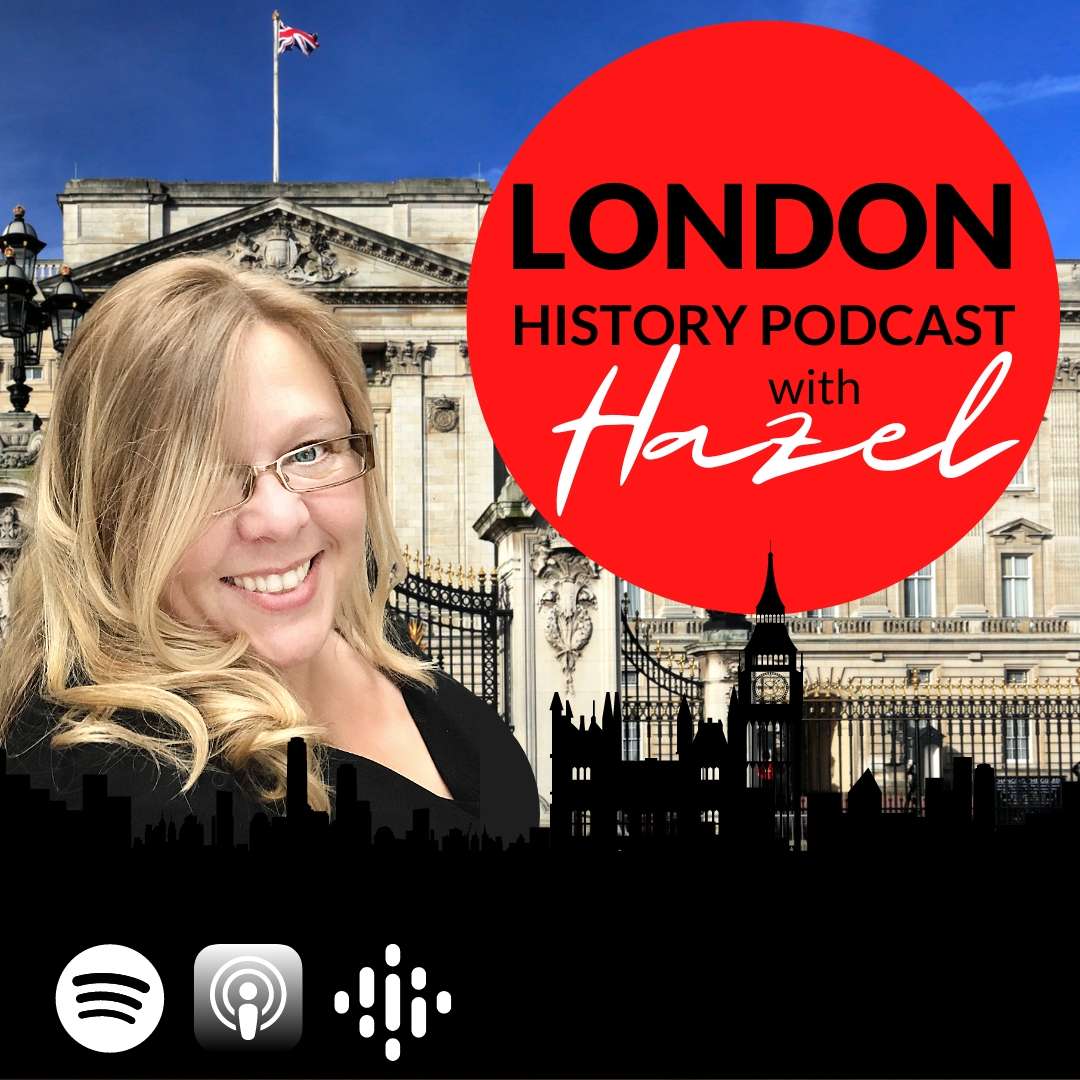
 Hazel Baker: Hello and welcome to London Guided Walks
Hazel Baker: Hello and welcome to London Guided Walks  Ian McDiarmid:
Ian McDiarmid: